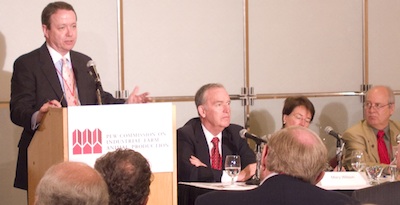The Pew Commission on Industrial Farm Animal Production: 5-Year Follow-Up
Each year, Americans raise and slaughter approximately 10 billion animals, primarily for domestic consumption. Most consumers, however, have no idea how the meat they purchase at the supermarket is produced since the advertising is so misleading: images of happy cows in pasture producing milk and chickens being raised in spacious buildings while the company CEO walks among them making sure they are eating a healthy diet.
American meat production began changing rapidly in the 1950s. As we experienced greater prosperity following World War II and European agriculture was still recovering from that conflict, U.S. companies began pushing for more intensive animal agriculture to meet the demand.
The production of broilers, the chickens we raise for meat, led the industrialization of animal agriculture and is a good example to highlight since broiler production today comprises about 8.9 billion of the 10 billion animals raised and slaughtered every year. In 1950, the U.S. produced approximately 581 million birds with production in virtually every state on over 1.6 million farms. By 2007, broiler production increased to 8.9 billion birds on only approximately 27,000 farms. That’s a 1,400 percentage increase in production on 98 percent fewer farms. It doesn’t take a mathematics wizard to know that means poultry production is heavily concentrated in large operations. The other food animal species—swine, dairy, turkey, laying hens, and beef cattle—have followed similar trends to varying degrees.
In 2005, the Pew Charitable Trusts and the Johns Hopkins Center for a Livable Future at the Bloomberg School launched a two-year study, the Pew Commission on Industrial Farm Animal Production, to review the public health, environment, animal welfare, and rural community problems caused by this intensive animal production. The charge to the Commission was to develop consensus recommendations to remedy those problems.

The Commission, on which I served as executive director, was comprised of members from several disciplines; public health, medicine, animal health, ethics, state and federal policy, and producers. Former Kansas Governor John Carlin was the chair, and Dr. Michael Blackwell, then the Dean of the College of Veterinary Medicine at the University of Tennessee–Knoxville was the vice chair. Dr. Blackwell also had served for many years at the FDA and as an Assistant Surgeon General. Bill Niman, Fred Kirschenmann, Bernie Rollin, Marion Nestle, former USDA Secretary Dan Glickman, and Fedele Bauccio were among the members.
Over two years, the Commission conducted 11 meetings in all parts of the U.S., visiting egg production, swine production, dairy production, large beef cattle operations, and broiler production and processing. Eight technical reports were commissioned with leading academics from across the country to help inform the group’s deliberations. The members held two public hearings, reviewed thousands of pages of material and deliberated for more than 250 hours to reach their consensus recommendations.
The Commission’s final report, Putting Meat on the Table: Industrial Farm Animal Production in America, was released five years ago this week. The general finding of the Commission was that the current industrial animal agriculture production system is not sustainable. It represents an unacceptable level of threat to public health, an unacceptable level of damage to the environment, is harmful to the animals housed in the most restrictive confinement systems, and is harmful to the long-term economic health to the communities near their location.
The 24 consensus recommendations included: banning the non-therapeutic use of antimicrobials in the production system, phasing out and then banning gestation crates for swine, restrictive veal crates, and battery cages in egg production. In addition, the Commission recommended fully enforcing the antitrust laws to help medium and small independent producers, bringing more factory farms under regulatory oversight, and phasing out and banning liquid manure waste management systems.
The industrial animal agriculture industry is not monolithic and their response to the establishment of the Commission ranged from wary cooperation to open hostility. Reaction to the final report by the industry was uniformly negative, and they have worked aggressively in the last five years to oppose any progress on implementing the recommendations. In fact, the opposition by the industry to the recommendations truly highlights what I came to see as the agro-industrial complex. Much like the military industrial complex President Dwight Eisenhower warned the country about upon leaving office in 1961, the agro-industrial complex is comprised by the iron triangle of industrial agriculture companies, their paid researchers at many of the major land grant colleges, and the beneficiaries of their campaign contributions in the U.S. House and Senate. But the release of this landmark report encouraged animal reform groups to keep working and informed their efforts.
The Center for a Livable today has undertaken a project to analyze the original recommendations of the Commission and to assess the impact and analyze the continued relevancy of the original report. It will be a thorough and unbiased review. The findings and conclusions of that effort will be released in a few weeks.
Image: Chris Stevens